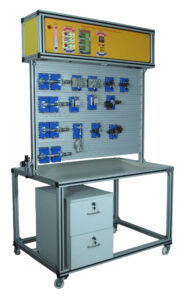
Description
This trainer explains the physical principles of pneumatics apart from describing the basic components along with their constructions and functions. It also gives advanced theories and comparatively complicated circuits.
Pneumatically driven devices can be regulated by electrical controls very efficiently. Due to this electro-pneumatics is widely used in all industries for a variety of applications. This combination of electrical and pneumatic control is very effective tool in automation. Optionally, sliding arrangement for in-use component mounting can be provided along with component storage facility.
Components
- Single acting cylinder
- Double acting cylinder
- 3/2-way valve, manually-actuated, Normally Closed, 2 nos
- 3/2-way valve, pneumatically-actuated, spring return
- One-way flow control valve, 2 nos
- 5/2-way valve with manually-operated switch
- 5/2-way valve pneumatically-actuated, spring return
- 5/2-way pneumatic actuated valve double pilot
- 3/2-way roller lever valve direct actuation Normally Closed, 2 nos
- Shuttle valve (OR)
- Two-pressure valve (AND)
- Pressure gauge 0-16 bar
- Manifold with self-closing NRV, 6-way
- Pushbutton station
- Relay station
- 3/2-way single solenoid valve with LED
- 5/2-way single solenoid valve with manual override and LED
- 5/2-way double solenoid valve with manual override and LED
- Power supply unit
- Profile plate
- Pneumatic Workstation
- Carrier for mounting components
- Cut section model for pneumatic components: Cut section of Double acting cylinder, Cut section of 5/2 Hand lever valve
- Compressor unit